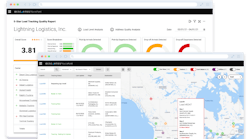No texting and driving. Don't fall asleep behind the wheel. Keep your eyes on the road.
We've all heard the cautionary phrases and seen them pasted on billboards dotting every highway. Yet, American drivers are increasingly failing to take them to heart. The widespread use of smartphone technology and the pressure of "productivity culture" to stay awake longer has fueled a new leading threat to road safety: distracted driving.
A recent AAA study found for the first time that distracted driving is the most significant danger on the road. The study states that 88% of survey respondents believe distracted driving is on the rise, topping concerns about aggressive driving by 20%, drugged driving by 33%, and drunk driving by 45%.
For fleet managers whose top priority is keeping their drivers and the community safe, and vehicles free from damage, the first step in mitigating risk related to distracted driving is to understand the neuroscience behind it. Creating respect for the issue among employees goes deeper than simply explaining the consequences. Though impactful, statistics are often received with an "it won't happen to me" mind-set.
It's important for the drivers themselves to understand the cognitive processes occurring when they drive while distracted, so they understand and appreciate the individual impact they have on the road and on their company as well as their responsibility to practice safe driving.
The science
There are three primary categories of distraction: visual, manual, and cognitive. The on-the-road implications of the first two are fairly intuitive. Visual distraction involves a driver taking his or her eyes off the road, and manual distraction involves taking his or her hands off the wheel. In both cases, there is an increased risk of swerving or drifting out of the lane, and the driver's ability to see and respond to a potential accident is significantly impaired.
The implications of cognitive distraction, when a driver takes his or her attention off the driving task, are more nuanced. Cognitive distraction often leads to inattention blindness, the failure to see critical cues in the driving scene because the driver's attention is focused elsewhere—even if his or her eyes are focused on the road.
Texting is the most alarming form of distracted driving because it involves visual, manual, and cognitive distractions at once. For example, sending a text may take a driver's eyes off the road for five seconds. At 55 mph, that's like driving the length of a football field with your eyes closed.
Fatigue is another often-overlooked form of distraction, sharing similar cognitive effects and comparable impacts on human performance error. A person getting between 5.5 and 6.4 hours of sleep in the prior 24 hours, or as a cumulative daily average over the past seven days, has over double the relative risk for error than does a person with just one or two more hours of sleep. That said, even if a driver adheres to the federal safety rules about rest breaks by getting the required quantity of sleep, it's important to emphasize the quality of sleep during this time.
Fatigued drivers are essentially driving without conscious attention and lack the ability to notice and react to changes in the driving scene. When combined with additional distractions, like glancing away from the road to take a sip of coffee, the risk of a crash grows exponentially.
The solution
For fleet managers, understanding the human performance science behind distracted driving not only underlines the importance of preventing these distractions but provides a stepping-stone toward effective prevention. Change may begin with policy, like mandating that drivers pull off the road to take phone calls and eat meals or requiring drivers to achieve a certain amount of sleep before getting back on the road.
However, meaningful, sustainable change requires a behavioral and organizational shift to a workplace culture that truly values and prioritizes safety. A few important steps in that process include:
- Establishing company alignment on continuous, sustainable goals and stepping up as a leader to take ownership for outcomes;
- Building capabilities that allow all employees to take control of their brain behind the wheel;
- Equipping all departments with clarity on how they influence a safe trip and what actions are critical for them to perform to keep risk low;
- Focusing on exposures rather than injuries as the driver for change and the measure of improvement; and
- Providing employees opportunities for meaningful engagement, like seeking their help to identify solutions to safety and operational reliability problems through contribution to safety governance conversations.
Above all, combating the dangers of distracted driving starts with understanding exactly what the dangers are. Through the lens of human and organizational reliability, we can address distracted driving, and fleet managers will ultimately be able to apply a systemic improvement to foster safety on the road.



